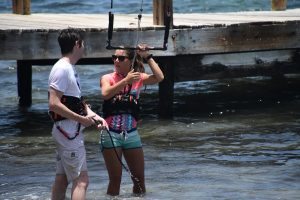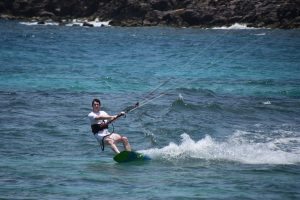On Friday morning I had Mark booked for a 3-hour lesson of Kitesurfing. As he arrived we discussed his riding level and what expectations and goals he had set for his lesson. He told me that he had started Kiteboarding a few years back and even has his own kite and board at home. But as he lives about 6 hours from the coast he hadn’t been getting much riding time in. And because of that, he wanted me to help him get more comfortable with launching and landing his kite as well as consistently riding upwind even in more challenging conditions.
As we arrived on the Kitesurfing beach and observed the conditions we found that the wind was at a medium strength with some gusts, probably ranging between 16 to 19 knots. We decided to go for the 12m kite. The constant changes in the wind strength that day were just the challenging conditions we were looking for to improve Mark’s Kitesurfing skills. It’s typical for riders of his level to be able to stay upwind in the perfectly steady wind but struggling when the wind is a bit inconsistent. As a passionate Kitesurfer you will want to hit the water not just on these perfect days but anytime you get the chance to get away from work and get on the water. So it’s essential to know what to do on those days to still enjoy your Kiteboarding session to the fullest.
After setting up and going through all the safety features of the equipment I launched Mark and let him go for his first run. He generally showed good control of the board and was very confident on the board due to regular Wakeboarding as well as Snowboarding trips. All board sports are related and experience in any of them definitely helps Kitesurfing students to progress much faster.
As expected, Mark was having a hard time finding the right power to consistently go upwind. So I met him down the beach to take the kite off him and we talked about how he could improve.
There are always to variables in Kitesurfing, one is the amount of power that we get from the kite the other is how much resistance we hold with the board. The power of the kite varies obviously depending on the strength of the wind. We also have control over the power by adjusting wherein the window we position our kite as well as how much we pull the bar in. When we face gusty conditions we have to constantly adjust our bar pressure so we won’t get too much power which will result in speeding and difficulties holding the edge of the board down or too little power which will result in the board sinking. The other variable is how we stand on our board and how we use our weight. When the wind is strong we can put more weight into the harness which results in a position that applies more heal pressure and therefore more edging of the board. But when the wind gets a bit lighter we need to be ready to get our weight more forward and over the board. Kitesurfing requires constant adjustment, it’s a feeling that we need to learn, not just one position. It’s a dance with the wind and water.
Mark was mostly struggling with his position on the board. He was hanging too far back which resulted in him falling back or sinking when the wind had a lighter moment. I also wanted him to stop looking at his kite and instead, look where he wanted to go…upwind. Our body naturally follows our head, so looking upwind will help him turn his body more upwind and point the board in that direction as well. After just a few runs Mark was able to follow my tips and maintain his height, going back and forth without ending up on the beach.
Next Mark wanted to work on improving his turns. He kept on sinking back in the water while changing direction. I told him to watch his timing of initiating the turn with the kite and board. He was taking too long to turn the kite compared to the board and that’s why he was losing power. Paying closer attention to his timing Mark was quickly able to do smooth turns on both sides.
At the end of his lesson,

Sandy instructing Mark

Riding upwind
Mark was riding very comfortably on his own even doing small jumps over the chop. Yet another fun and successful Kiteboarding lesson with St. Kitts Water Sports.








